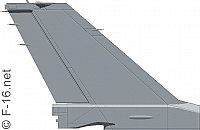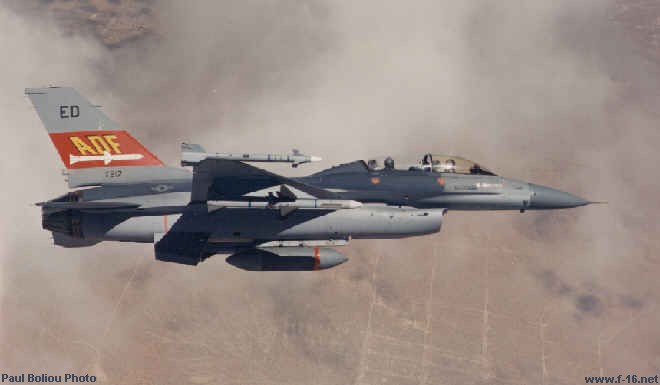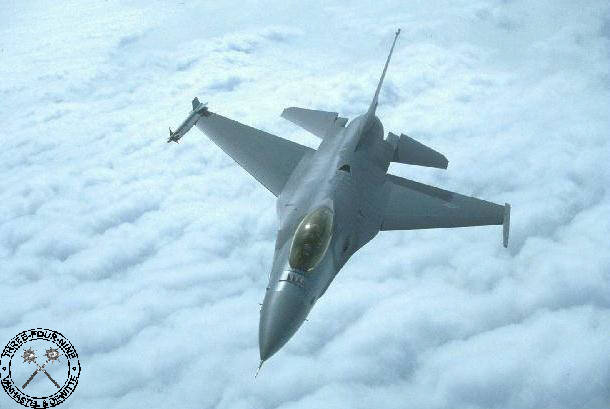 |
F-16 ADFAir Defense Fighter |
History
In October 1986, the USAF announced that operational block 15 F-16A/B aircraft would be converted to air defense fighters for the Air National Guard, and would take over the fighter interception mission, providing the primary defense of North America against bombers and cruise missiles.

The first F-16A ADF conversion was completed in February 1989, while a contract was placed for kits to update and modify a total of 270 F-16A/B's at the Ogden Air Logistics Center in Utah. The Block 15 airframes used for the ADF program were all meant to be upgraded to block 15OCU standard, and both programs ran in conjunction. Aircraft entering the Ogden ALC for ADF upgrade also received the Block 15OCU avionics installation. The net result is that all ADF aircraft are Block 15OCU airframes. The last ADF left Ogden in 1992.
Structure & Avionics
Modifications included Bendix King (now Allied Signal) AN/ARC-200HF/SSB radios with Have Quick II Secure Speech Module and the Teledyne/E Systems Mk.XII Advanced IFF system (APX-109). The APG-66 radar was modified (designated APG-66A) to provide look down/shoot-down capability, enhanced small target detection, and CW (Continuous Wave) illumination for AIM-7 guidance.
A 150,000 candlepower night identification spotlight was installed on the port side of the nose (below and in front of the cockpit) to aid in the identification of nighttime intruders. The aircraft were equipped to carry 600 (US) gallon (2,271 liter) external drop tanks, and to carry 6 BVR missiles such as the AIM-7 Sparrow or AIM-120 AMRAAM.
Modifications & Upgrades
The ADF aircraft can be distinguished from "standard" F-16A/B's by several external identifying features, such as long and thin horizontal bulges on the base of the vertical tail (only A-models), plus a set of four blade antenna, nicknamed "bird-slicer", carried just forward of the canopy (as part of the IFF system).
The bulges are caused by the relocation of the Bendix-King AN/ARC-200 high frequency single-sideband radio to the leading edge of the fin. This in turn caused the flight control accumulators, which were installed one over the other, to be relocated to either side of the tail fin. The bulges were installed to provide sufficient room for these accumulators. Note that, since the Bravo-model ADF's do not have the Bendix HF radio, they also don't have the bulges.
Production
All ADF F-16s are modified airframes. Existing Block 15 models where converted to the Block 15OCU upgrade and to ADF standard at once. In total, 271 airframes, consisting in 246 A-models and 25 B-models have been converted between 1989 and 1992. Minor differences exist between the A-model and B-model as described earlier.
Because of the fall of the Berlin wall in 1989 and the opening of relationships between West and East, the program had lost its major reason of existence, being the protection of the North American continent against Russian bombers flying over the North Pole. Although the program was finished and all aircraft stayed into service with the Air National Guard detachments, they were the first to be mothballed at AMARC with the first major restructuration of the USAF. This proces started already in 1994. Currently only 2 ANG squadrons still fly the type, with them probably being converted in the near future.
A lot of these ADF F-16s are a very cheap and quite modern asset for allied countries. These aircraft have relatively low flying hours on their airframes. A lot of them are sold on the second-hand market. Jordan was the first to receive 12 A-models and 4-models under the Peace Falcon program in 1997. Recently, Thailand has acquired another batch of 15 A-models and 1 B-model under the Peace Naresuan IV program. Also the Italian Air Force is receiving 26 A-models and 4 B-models under a 5-year (extendable to 10 years) lease agreement called Peace Caesar.
Specifications
Engine: One Pratt & Whitney F100-PW-220 turbofan, rated at 14,590 lb.s.t. dry and 23,770 lb.s.t. with afterburning.
Maximum speed: Mach 2.05 at 40,000 feet. Service ceiling 55,000 feet. Maximum range 2400 miles. Initial climb rate 62,000 feet per minute.
Dimensions: wingspan 32 feet 9 1/2 inches, length 49 feet 3 1/2 inches, height 16 feet 8 1/2 inches, wing area 300 square feet.
Weights: 16,285 pounds empty, 25,281 pounds combat, 37,500 pounds maximum takeoff.
Question: Why was the search light mounted on the port side. My understanding of air intercept procedures is Lead was to fly along the port side of the suspect aircraft to ID while Wing flew behind to observe and , if needed , engage. It would seem trying to ID an aircraft to your starboard side with the light on the port side would not work too well. What was the logic?
Please use this form to add any list any error or omissions you find in the above text.
Note: your comments will be displayed immediately on this page. If you wish to send a private comment to the webmasters, please use the Contact Us link.

